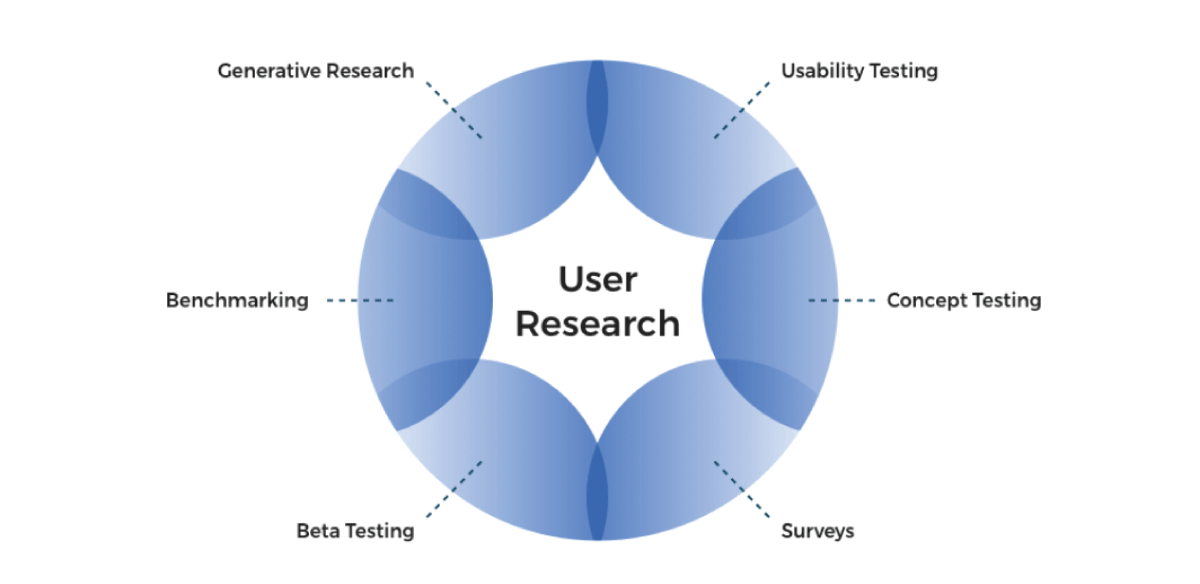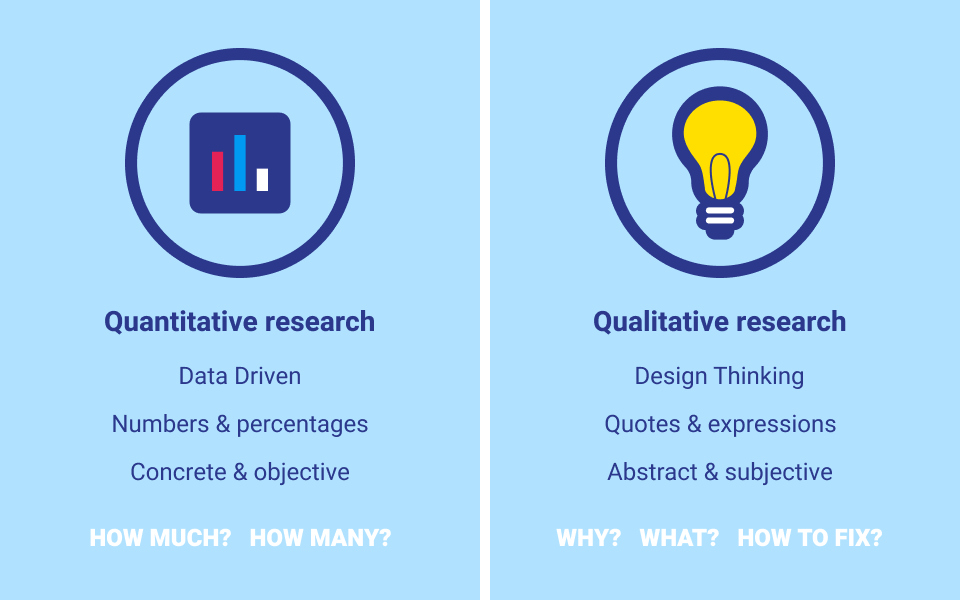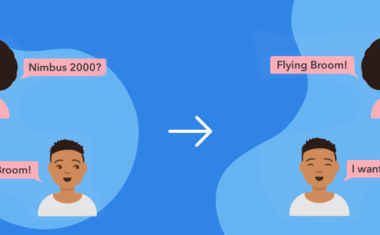How To Become a UX Researcher (and What Will You Really Do?)

In this article
The UX (user experience) industry is all about making products, websites, apps, and services easy and satisfying for customers to interact with. The fundamental goal of UX is to make a product as simple to use as possible so that it’s accessible to customers of all kinds.
To make this a reality, UX teams have to know exactly what customers need, want, and expect from the product. It’s a UX researcher’s job to find the answers and pinpoint the needs of the end users.
If you’re interested in becoming a UX researcher and want to learn more about what they really do, then keep reading—we’ll tell you everything you need to know!
What Is a UX Researcher?
A UX researcher’s primary task is right in the name: research. By using various research and surveying techniques, UX researchers identify problems to be solved, as well as various desires, needs, and expectations that should be met in order to satisfy customer needs and experience. They then use their findings to help guide UX and UI designers in order to create a useful product.
What Does a UX Researcher Do?
Let’s take a closer look at the main tasks of a user experience researcher.
Conduct User Research To Help Design Better Experiences

To build a good product, it’s imperative to understand the people who are going to use it. UX researchers aim to do this by surveying real potential users and creating “user profiles” whose journeys they can simulate and follow.
User Recruitment
Finding the right people to contribute to surveys and data collection is also a part of a UX researcher’s job. The product will have a target audience, but voices outside of this spectrum need to be considered, too. Surveying a selection of people that cover as many bases as possible helps a UX researcher make sure that the data collected is of good quality.
Observe and Collect Data (Usability Testing, Face-to-Face Interviews, User Surveys)
As the development of the product progresses, different kinds of research and data collection can be carried out.
Initially, surveys and interviews will be used to gauge the wants, needs, and expectations of potential users regarding the product. Later, prototypes can be used to conduct usability testing, allowing designers to see if they are heading in the right direction.
Analyze Data To Find Patterns and Trends

UX researchers generally work with two kinds of research: qualitative and quantitative. Qualitative research deals with aspects that don’t translate well into numbers. This kind of research is used to find out why users feel a certain way and it involves talking to real people and listening to their opinions.
Quantitative research, however, is all about the raw data: what people do, how they do it, and how many people are doing it. By analyzing data of this type, UX researchers can find patterns and trends that can lead to better design principles. For example, knowing how many people could successfully find a certain feature will let the designers know whether the feature needs to be made more visible or not.
Collaborate With Designers, Developers, and Product Managers To Create Solutions That Improve the User Experience
One of the most important aspects of a user experience researcher’s job is making sure the right findings get to the right people. If a researcher kept the results of a survey to themselves, that valuable information could never be put to use.
Get To Know Other Design Students
Reyna Martinez
Associate UX Designer at ServiceMax
Trixy Woodhouse
UX Designer at Nike
Arin Soukoule
Design Experience Analyst at Accenture Interactive
How To Become a UX Researcher
-
Read and Learn As Much as You Can To Decide if UX Research Is the Right Fit for You
-
Meet the Educational Requirements
-
Develop the Requisite Skills
-
Gain an Understanding of the Essential Tools
-
Get Practical Experience by Working on Projects and Build Your Portfolio
-
Your Network Is Your Net Worth
-
Get a Mentor
-
Tailor Your Resume to the Job You’re Applying To
If you’re interested in becoming a UX researcher, there are a lot of things you can start doing right now that will begin to prepare you for your new career path.
Read and Learn As Much as You Can To Decide if UX Research Is the Right Fit for You
The more information you have, the better—that’s a mantra that UX Researchers live by!
Blogs
Blogs are a great way to gain practical information on the job, like what kinds of skills UX researchers need, and for reading insights and opinions of real-life workers in the industry.
Short Courses
Before signing up for college programs or 24-week bootcamps, trying out a few short courses can help you get a taste of the industry, the role, and the kind of studying you’d have to do.
Podcasts (UIE Brain Sparks, UXPod, and Boxes and Arrows)
Get personal anecdotes, professional opinions, and useful insights by listening to podcasts that involve conversations between industry professionals.
Here are some of the podcasts we recommend that you check out:
YouTube Videos
Get to know the ins and outs of the job by following content creators who are currently in the industry This is a great way to get honest opinions on the job of a UX researcher that cover the cons as well as the pros.
Books
Fill up on the wisdom of industry veterans and professors by reading UX research books and textbooks.
Meet the Educational Requirements
Once you’re well-informed and thoroughly convinced that UX research is the field for you, it’s time to really start learning. There are big decisions to make here, and they will cost time and money, so research is key.
Don’t Necessarily Need a Degree, but It Can Be Helpful, Especially in a Related Field
UX Research is a job that revolves around understanding people, and many researchers have backgrounds in subjects like behavioral science, psychology, sociology, anthropology, and humanities. A degree in one of these relevant fields or similar will help get your foot in the door, a college degree is not a necessity.
Pursue a Certified Online Course or a Bootcamp
If you don’t have a degree in a related field or don’t have a degree at all, pursuing a UX bootcamp can be a great way to get a relevant education and hands-on experience. With courses that are focused specifically on UX research, you’ll be able to learn a lot of necessary skills in a short amount of time.
The purpose of a bootcamp is to get you job-ready, so you will be learning from industry professionals in order to prepare yourself for the job.
Develop the Requisite Skills

Source: Berkeley Extension
While you’re studying with an online UX course or college program, you’ll also need to develop your skills on your own time, as well.
Technical Skills
While user experience researchers are less likely to have front-end coding skills than a UX designer, it’s still good to have some technical skills. If you have or want to develop skills in HTML and CSS, for example, these can be useful when collaborating with UI designers.
- Qualitative Research
There are many different qualitative research methods, such as focus groups, surveys, and interviews. Learning the pros and cons of each and when to use them is an important skill.
- Understanding UI Design
Designing the UI of the product will not be your job, but helping guide a UI designer will be. You’ll need a basic understanding of UI design to know how your research findings should affect the design of the user interface.
- Creating User Personas
User personas help researchers create a user-centered design. They are fictional personas with personalities and needs taken from data on real people and used in various stages of the design process.
- Producing User Journey Maps
Simulating a user persona’s journey with a product helps keep the design process on track. Are their needs being met? What needs to be changed to improve the experience for them?
- Generating Insights From Data
Some skills with data visualization and analysis (with tools like Microsoft Excel and Tableau) will be necessary to structure and understand larger sets of data that are collected through surveys and interviews.
- Empathy Mapping
Understanding the fine points and nuances of how a user’s experience can make them feel will help UX researchers avoid mistakes that will turn a user away from the product.
- Creating Prototypes and Wireframes
Helping UI designers create prototypes and wireframes will improve your ability to collaborate with them and give them practical examples of how your research can be implemented into the design project.
- Usability Testing
Once prototypes exist, they need to be tested. Potential users, in-house testers, and the UX team themselves can take part in testing to assess how easily and well features can be accessed and used.
Soft Skills
The UX research role involves talking to users and encouraging them to share their thoughts and feelings, collaborating with the rest of the UX design team, and convincing them to take your research on board.
This requires excellent soft skills and communications skills, to the extent that UX practitioners and hiring managers believe soft skills to be the most important skill set in UX.
- Problem-Solving
To help push improvements in design, researchers should be able to suggest solutions to the problems they are communicating.
- Analytical Mindset
Analytical skills involve using the information at your disposal to figure out a relevant and objective cause of a problem or solution to that problem.
- Active Listening
Listening to users’ opinions is by far the most important thing for a user experience researcher to do. If you don’t truly listen to the thoughts and feelings your respondents are trying to communicate, your data collection will not be useful and relevant.
- Critical Thinking
Critical thinking allows researchers to spot anomalies in data and fix problems before they grow bigger. It’s an important skill to be able to notice when something doesn’t quite fit and then find out why.
- Organization
Conducting interviews, surveys, analysis, and collaborating with other teams all at the same time all require good organizational skills.
- Teamwork
Teamwork is extremely important for a UX researcher. There is no way to get your research used other than to work with others.
- Communication
Communication is a large part of collaborating with others and conducting research with users. The key is being as clear as possible, and as friendly and respectful as possible.
- Creativity
Creativity will help a researcher come up with new ways to collect data, new ways to view it, and how to best use it in the design thinking process.
Gain an Understanding of the Essential Tools
During your study, you can begin to get a handle on the wide range of tools you would be using on a daily basis as a UX researcher.
Recruitment: Ethnio, User Interview
- Ethnio: A recruitment and management system for user participants.
- User Interview: A dedicated site for recruiting survey and interview participants.
Surveys: Google Forms, SurveyMonkey
- Google Forms: Free survey administration software from Google.
- SurveyMonkey: Free and popular survey software.
Usability Testing: Userlytics, Lookback
- Userlytics: A remote user testing platform.
- Lookback: A usability testing platform.
Analytics: Google Analytics, Hotjar
- Google Analytics: Software to track and report traffic on websites and apps.
- Hotjar: Software for user behavior analytics and heatmaps.
Research and Data Management: Dovetail, AirTable
- Dovetail: Analyze, synthesize, store, and share customer research.
- AirTable: A low-code platform for building collaborative apps.
Get Practical Experience by Working on Projects and Build Your Portfolio
Education and skills are the must-haves for getting into the UX industry, but practical experience and portfolio work will give you a real edge in the job market.
Volunteer Work
Helping out small businesses or projects that otherwise would not have any UX research is a great way to test out your skills and gain some experience.
Sample Projects
Sample projects are a great way to build your portfolio and showcase the skills you have and the kind of research you can do.
Apprenticeship or Internship
Apprenticeships and internships are invaluable experiences that can give new UX researchers a real advantage during job searching. Opportunities can come from unexpected places, so it’s good to check apprenticeship sites regularly.
Freelance
Filling your time as efficiently as possible is a good habit when studying and preparing for a career change. If you don’t have a larger project, apprenticeship, or internship going on, then try out some freelance work until you find something bigger. Your projects will make a good addition to your portfolio.
Your Network Is Your Net Worth
Making friends within the industry is important for your growth and for finding good opportunities.
Check out some of the methods below to get started:
- Online communities such as Discord and Reddit
- UX conferences
- Hackathons
Try your best to connect with other students and industry professionals alike—it might help you down the line.
Get a Mentor
If you meet a professional in the industry that is willing to take you under their wing, take advantage of this unique opportunity. Mentorships do not have to be formal and official partnerships, but finding someone with experience who is willing to answer your questions is very valuable.
Tailor Your Resume to the Job You’re Applying To
To create a compelling UX resume, you should tailor it to the job you’re applying for. Companies want to know that you’re passionate about making their products the best they can be, so doing the research and catering to each specific company will set you above all the generic resumes.
How Much Can You Make as a UX Researcher?
Here are some average salaries for UX researchers at different stages in their career paths.
Entry-level UX Researcher
In your first year of work, Glassdoor reports the average total salary for an entry-level position to be around $108,009.
Mid-level UX Researcher
After around two years, average salaries rise to around $124,732.
Senior-level UX Researcher
Senior-level UX researchers with 8 or more years of experience can expect to earn an average salary of $152,764. However, Glassdoor reported wages as high as $282,000.
FAQs About Becoming a UX Researcher
Here are some of the most frequently asked questions about becoming a UX researcher.
Are UX Researchers in Demand?
A search on Glassdoor lists 2777 UX research job postings in the United States. The role is mostly in demand at large companies with big UX teams, whereas small companies may choose to combine the roles of UX designers and researchers.
Is UX Research Hard To Learn?
You will need to be a motivated and determined individual to switch careers and become a UX researcher, but UX research itself is not intrinsically hard to learn. With many courses and resources out there to learn from, it is a very accessible field to get into.
Related Read: Is UX Design Hard To Learn?
Can You Become a UX Researcher Without a Degree?
Degrees are always useful tools to help get you noticed and get you interviews, but they are not a 100% requirement. Individuals with experience equivalent to a degree, good portfolios, and other certifications can get into a career in user research.
How Can You Become a UX Researcher Without Any Experience?
While you would struggle to get a job as a UX researcher without any qualifications and previous resume entries, you can begin on the path to becoming a UX researcher without prior experience.
You simply need to earn experience as you study and work toward putting yourself on the job market. This can be done with freelance work, portfolio work, apprenticeships, internships, and more.
Since you’re here…
Interested in a career in UX design? Rise to the top of the CV pile when you enroll in our UX Bootcamp—you’ll get a UX job or your tuition money back. Take a look at our student reviews and test out our free UX curriculum to get a feel for our style and results. TL;DR: average starting salaries for our students = $85,440. Let’s do this.





